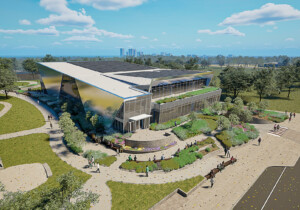With work ranging from houses and storefronts to city-scale master plans, Chicago-based UrbanLab fluidly navigates architecture and urbanism. Regardless of scale, the studio addresses complex social and ecological issues with straightforward yet ambitious proposals—while managing to introduce a hint of levity in every design.
Midwest editor Matthew Messner sat down with UrbanLab to talk about the Yangming Archipelago and how the studio works with water as a design component.
The Architect’s Newspaper: How does UrbanLab approach water as a resource for architecture and urbanism?
UrbanLab: Water, we believe, is the primary infrastructural framework and life-support system of cities. We think water infrastructure has the capability to unlock questions of how to best shape urban form and support healthy lifestyles. Today, the ways in which cities address their water challenges will be critical to their ability to prosper and grow. We see water scarcity as typically the result of shortsighted or poor planning strategies (or lack thereof) that use water only once before relegating it to waste. In this simple, linear model, water is typically castoff after its first use, at which time it becomes successively more polluted. We think this is crazy: Water is rarely so toxic that it can’t be salvaged and recycled again and again. As Buckminster Fuller remarked, “Waste is merely a resource in the wrong place.” So too is “waste” water that is routinely ejected out of cities instead of being kept and put back to work. Alternatively, UrbanLab’s water-based urbanism projects view water as part of a circular economy and ecology, where it keeps its value after each use, and ultimately returns to an original source.
How does this play out in the studio’s projects?
Each of our projects is a “bowl” of varying size and shape in which water circulates in semi-closed loops. Shifting to looping circular models that store water, from linear models that discard water, can replace scarcity with abundance, and help solve challenges of long-term supply and demand. We’re very interested to combine water infrastructures with architecture and landscape to find new urban forms.
How is water-based urbanism deployed in the current Changde project?
Our client, Changde’s planning bureau, aims to realize the plan in the next five to ten years. Currently, the project site is sparsely developed farmland bordered by high-density superblocks. At the center of the site is a highly polluted lake that is prone to flooding. Our primary design concept is a continuation of ideas we’ve been developing: To reimagine water as an amenity (not a problem) for people. The lake is re-planned as a bowl-shaped “central water park” for the entire city.
What are some the ecological aspects of the design?
To help clean the lake, water-filtering infrastructures, or eco-boulevards—an idea we’ve been working on through several projects—pre-treat storm water runoff. Eco-boulevards are connected to additional water-filtering infrastructures such as tree-lined feeder roads, storm-water parks, and in-block rain gardens. Together, the streets and open green spaces are a porous framework of sub-bowls that naturally absorb and clean rainwater before [it enters] the lake. A fine-grained urban grid accommodates a mix of transportation options within and between eight new subdistricts. Compared to contemporary, car-centric urban grids in China that encircle gated superblocks, the geometry of our compact grid allows for a highly efficient bus transit system, reducing energy use and pollution. Bus stops and transfer nodes are planned within a 10-minute pedestrian walk to all new developments. In the lake, a group of new islands is planned. The “Central Business District Island” contains the most prominent new commercial buildings, and a chain of “Cultural Islands” contains new civic venues and gardens. The islands filter lake water and naturally enhance biodiversity and the living environment.
This article was part of our Oct. 12 issue which focused on how water is shaping today’s landscape architecture and urbanism. Communities face deluges and droughts—for some, the stakes can be survival itself, but others see opportunities for decadence. To explore these stories from around the U.S. and the world, click here.










